I have found a care sheet,Pm me if you want me to send it to you mate.
- - - Updated - - -
I have found some information about them.
Caring for Jumping Spiders.
My love for and knowledge of Jumping Spiders
While I have always loved animals and nature my entire life, interested in them enough to achieve a Master's degree in Biology, it wasn't until 2003 that I got so obsessed with jumping spiders, when I bought my first digital camera that could capture some of the spider's faces. It was then that I found out how unique they were appearance-wise. After doing many photo shoots, I discovered their personalities. Some were easier to work with than others, almost as if they "understood" that it was a photo shoot and that I wanted them to pose and stay in different positions and locations. Now, it has been years working with these spiders and I really enjoy sharing their photos on the internet and enlightening people all over the world, helping them to appreciate these tiny creatures. Many people have written to me with questions about their care, which inspired me to create this page, which is a compilation of my knowledge and the answers to all of the questions I have been asked thus far. The spider that changed my life the most and began my interest in spider-keeping, was Biglegs. Click on his photo below to read about my experiences with him.
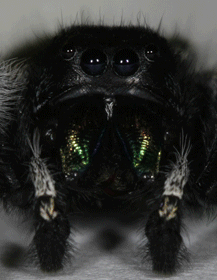
Temperaments of Jumping Spiders
Jumping spiders can be very enjoyable pets. They are one of the most intelligent spiders on the planet and they will love interacting with you. You will find that individual spiders have their own personalities. Some are shy and skittish. Others are more calm and just observe you. They are also one of the friendliest types of spiders, so you don’t need to worry much about being bitten, as long as you handle them gently. I have only been bitten a couple times (after handling hundreds of these types of spiders) and I blame it on myself by not handling it properly (read the section below on "Catching a potential pet"). It felt kind of like a pin prick each time---I'm not even sure that any venom was injected---it was more like a warning-bite I think.
Catching a potential pet
Jumping spiders are all around. You might even have some in your home already. Indoors, they love hanging out in sunny windows. Outdoors, they are also commonly found in the sun, often on brick walls or fences. They like the sun because it warms their muscles and they can move around faster. You will rarely find jumping spiders on rainy or cloudy days.
When you have located one, the best way to catch it is with a cup or other small container. With one hand, hold the cup in front of the spider, then try to coax it into the cup with the other hand. Do not grab or pluck at the spider as this could upset it. If you always allow the spider to walk to the place you want it to be, you will most likely never get bitten. If you squeeze the spider by picking it up directly, this is when it will get scared and might bite as a reflex.
Whenever you are handling your spider, you should also follow the same method to capture and release it.
Setting up a home
Jumping spiders are pretty easy to please. While a small container will work, remember that it won’t provide much space for your spider to exercise. If you are someone with a lot of free time and you plan to play with your spider every day, this probably won’t matter much. If you will be leaving your spider in its cage most of the time, you might want to provide it with about a cubic foot of space or more. If you do not allow your spider to exercise, it will become weak and will die earlier than it should. They need space to practice their jumps and to run fast.
Make sure your container has adequate ventilation, but that the holes are small enough to keep the spider inside. Although you could certainly decorate its home with items like branches and leaves, these things do make it difficult to find your spider sometimes, as it will make resting sacs (little silken “sleeping bags” where it will stay most of the time) inside curled leaves, etc.
I have found that a simple, slightly crumpled napkin or paper towel can make the spiders just as content. They often make their resting sacs within the folds of the napkin.
You need to provide sunlight, but not too much. If you have your spider in a plastic or glass terrarium, direct sunlight will heat up the cage so much you can "cook" your spider. I try to keep my spiders in a location so that their cage gets a bit of sunlight in one area for 4-5 hours a day. I make sure they have a place that is still shady (like napkin folds). I have had these spiders do fine in temperatures of 68-85 degrees Fahrenheit, although they may also do well a bit hotter or colder (I'm just going by what the temperatures generally are inside my home throughout the year).
Feeding your spider
Generally, you should try to feed your spider an insect at least every 2-3 days, although most can probably survive at least a week without eating. Hard-shelled beetles should be avoided. They also don’t care much for pill bugs. They also do not like ants which can pinch them and "inject" formic acid. From my observations, flies and small crickets are their favorite meals. Moths will also work well and like flies, cannot ever harm your spider since they can't bite. I also had one website visitor write in that she had a spider that enjoyed webworms, and another whose spider ate silverfish. If using crickets, you don't want to put in too large of a cricket because they do have the ability to bite. As a general rule, I don't put in crickets that are any more than 1.5X the length of the spider. You may even find that your particular spider has its own individual preferences as far as food choices go. I have found it very interesting to discover that certain pets of mine always sucked out the cricket legs first, while others preferred the head, and still others would start at the abdomen. Some would only eat crickets if they were very hungry and exhibited more of a preference for flies. I had some spiders that seemed to be annoyed by flies and would just kill them to stop them from buzzing around their cage. They didn't even suck out the juices.
In the warm climates, you should be able to catch some flies outdoors with a butterfly net made of fine mesh (cheap kid’s butterfly nets work great). When it gets colder (or if you don’t like the idea of catching your own flies), many pet stores carry “small” crickets. The large ones are usually too big and intimidating for most jumping spiders, but they can easily tackle the small ones. I have had some jumpers who have taken on large crickets, but not many.
To feed your spider, just drop the insect in its cage and wait for it to be pounced upon. When the spider is done eating it, you will want to remove the insect shells so that they don’t stink up the cage.
Watering your spider
Spiders breathe with structures called book lungs that are located in the abdomen of the spider (it does not breathe through any structures in its head as some creatures do). These book lungs are much like pages of a book, hence their name. If you put water on the abdomen of a spider, the water could get between the “pages” and it could suffocate. Spiders need very small droplets of water only. If you have a misting bottle, one small squirt of water mist on the side of its cage every few days should be plenty. Otherwise, just drip a few drops on the side of the cage. No puddles, or else your spider could drown.
Cohabitation and mating of spiders
It is generally suggested that you have a separate cage for each spider. If you put two females together or two males together, they will most likely fight to the death.
If you are put a male and female together, the outcome can vary. When I have tried to mate spiders by putting them in the same cage, I always make sure they have extra flies and crickets around. Sometimes, even with this precaution, for some reason, the female spider still attacks and kills the male (on some occasions, before even mating with him). If you still want to have two living spiders at the end, it works best to put the male and female together only for a very short period (a few days or less), then separate them after mating has taken place.
Females can store sperm for up to a year, so it is sometimes possible that the female you captured has already been mated and is just waiting for the right time to lay her eggs. This is a reason she may not mate with the male that you set her up with and will attack and kill him instead. You may want to keep her for several months to see if she makes an egg sac on her own.
Your adult spider's life and old age
If you captured a young spider, you may notice some interesting things as it ages. If it had orange spots or hairs, it is possible that they will turn white with future skin sheddings. You will also notice your male spider's front legs get longer and hairier as it gets older. The photos below are of the same spider after its fourth and fifth sheds. Notice how after the 5th shed, its markings are now white. It has large white tufts on its front legs that weren't there before.
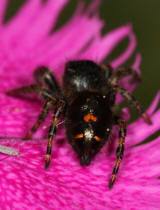
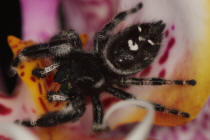
I have found that from baby to adult, jumping spiders shed about 5-6 times. The tiny hairs on the bottom of their feet (used for gripping surfaces) do not replenish after the last shed. Once these hairs start to wear out, you will find that your spider cannot climb the sides of the cage so well, and it probably won't risk jumping around much either. This is spider old age. The best thing you can do for it is provide surfaces that it can walk on. I line the whole tank with a napkin and even cover a few of the sides. This also acts as a cushion because sometimes your spider may slip and fall (just like old people). You should also quit giving your spider insects that can bite it, like crickets. Sometimes, they won't even try to attack a cricket anymore. I use flies or just recently dead crickets. The dead crickets work very well to prolong the life of an aging spider. I have kept spiders alive for 3 months or more like this when they refused to attack insects any longer. I just drop the cricket right near the spider's resting sac and it will come out and take it. While it is always sad to watch a friend die, you have to realize that they aren't supposed to live more than a year or two, and hopefully, you have provided him/her with an interesting and easy life.
Care of Egg Sacs
If you are lucky enough to have captured a female who has previously mated, you may witness her spinning a huge resting sac and laying a mass of eggs inside it. It may look something like the one below, only probably more protected. The one pictured was removed from its original location and moved here (not recommended, but this was in a bad location where they may have been crushed without intervention), so the eggs are more visible than in a normal resting sac. Sometimes, they are so well hidden in a corner sac that I don't even realize there are any eggs until I have babies emerging.
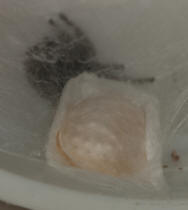
You will need to make sure the outer part of the sac does not get too dry. I usually try to mist it once a week with a spray bottle (just a tiny little spray). Try to avoid spraying in the direction of the entrance(s) to the sac. You also need to keep an eye out that the babies have not started emerging---you could drown them if you mist the sac during this period. It usually takes 2-4 weeks for the babies to become visible in the sac. They will actually shed their skin once while living in the sac before they start emerging. Allow the spiders to exit the sac on their own---it may take as long as one month for all of the spiders to leave the sac. As they leave, they are easy to blow into a cup (just like you're going to blow out a candle, you can blow in the direction you want them to go). If you try to touch them and move them into a cup with your finger or piece of paper, you will almost certainly crush them---they're just too delicate to be handled. The air-blowing method never hurts them.
I have normally left the female in the cage with the egg sac---I am not sure if anything would happen differently with the babies if she were removed. I just always figured I would do what was natural, and in the wild, she would stay with the sac. Sometimes animals communicate with chemicals called pheremones, that we can't even perceive, so it is possible that she could be sending chemical signals to her babies while they develop, who knows? I also provide food for her, usually in the form of small crickets or flies. Sometimes, a nesting female may not even come out to eat them, but I think they should still be provided. I have had some females continue to eat on their normal schedule (a fly every few days). I have had other spiders not eat a single thing for an entire month. They always drink water though.
Your female may lay another sac shortly after her previous babies have emerged, or even sometimes create a new sac in another area of the cage before. You may wonder how this is possible if you haven't seen her mate with a male. Interestingly, she has the ability to store sperm from male spiders for months---she doesn't have to lay all her eggs at once. She will save the sperm and fertilize the eggs as desired.
Unfertilized Egg Sacs
Don't get too excited---Just because a female has laid an egg sac does not mean you will be having baby spiders. I have discovered that if a female spider is kept long enough without a male present, she will go ahead and lay her eggs unfertilized---I think this prevents her from dying. , so I think jumping spiders must avoid death by laying the eggs unfertilized. I have had several females do this in captivity. The eggs look fine at first, but then they just dry up. I have even observed a case where the female ate the unfertilized eggs after a few weeks. If you see your spider spinning a very large resting sac in a corner or other nice location, she is probably ready to lay eggs. I am still not sure if it is best that she mate before this happens or during this process---I am still studying these spiders.
Care of Baby Spiders
It would be very difficult to care for a large number of babies, especially since they will become cannibalistic if not separated from one another. I suggest letting them go during mild weather (early morning or early evening). While many times, one sees adult spiders hanging out on the warm bricks and window ledges of houses, young spiders cannot handle the heat and will dry up within minutes (unfortunately, I found this out from experience, so please learn from my mistake!). Do not let them go in a sunny location. Try to find a place that will also offer shelter if it should rain. If you have a porch that is not in direct sunlight, I think that is a pretty good place to release them. I usually catch 10 in a cup, then set the cup outside and let them leave on their own. Sometimes they may stay in the cup for a few days in small groups.
As soon as the baby spiders leave the sac, they are going to be hungry. They will cannibalize each other if you don't feed them. The only way to raise young spiders is to find very tiny insects. This would be difficult if it weren't for pet stores that sell flightless fruit flies. You can also order them online if you cannot find a pet store that stocks them. Their cultures of
Drosophila melanogaster wingless fruit flies will last for several weeks to a month and there are more than enough flies (I had to dump a lot outside because there were way more than I needed). This species is best for very young spiders because they are very small flies and don't have any wings at all. There is another commonly stocked species at pet stores, called
Drosophila hydei, that is larger than
D. melanogaster. This species has wings, but they are not used. You can also make your own cultures and save a lot of money. The
Carolina Biological Supply Company carries all your Drosophila culture needs, from vials, foam tops, and a mold-resistant food mix (just add water and yeast). I start a new culture every week or two, and that way, I always have live flies for my babies.
To make sure that I kept babies that ate, I put flies in with 4-5 spiders at a time and then separated out the spiders that ate. I tried to give all the spiders a good first meal before their release, but some just didn't seem ready to eat. It is also a good idea to use the air-blowing method to handle fruit flies as they are also very easy to crush. The babies usually won't touch them unless they are moving around, so you don't want to try to feed them dead flies.
You can temporarily house several recently-emerged babies together provided that you keep them well-supplied with fruit flies.
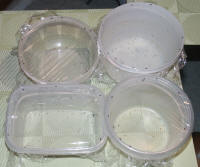
As the spiders get larger, they will need to be separated into individual containers. You can try feeding them some larger insects too. However, you should avoid ants. They may seem small and harmless but their bite injects something called formic acid that can be toxic to spiders. I've seen ants devour live crickets and bite their legs right off. Also, beetles and roly-polies don't work so well because of their hard shells. They seem to prefer soft-bodied flies and crickets.









